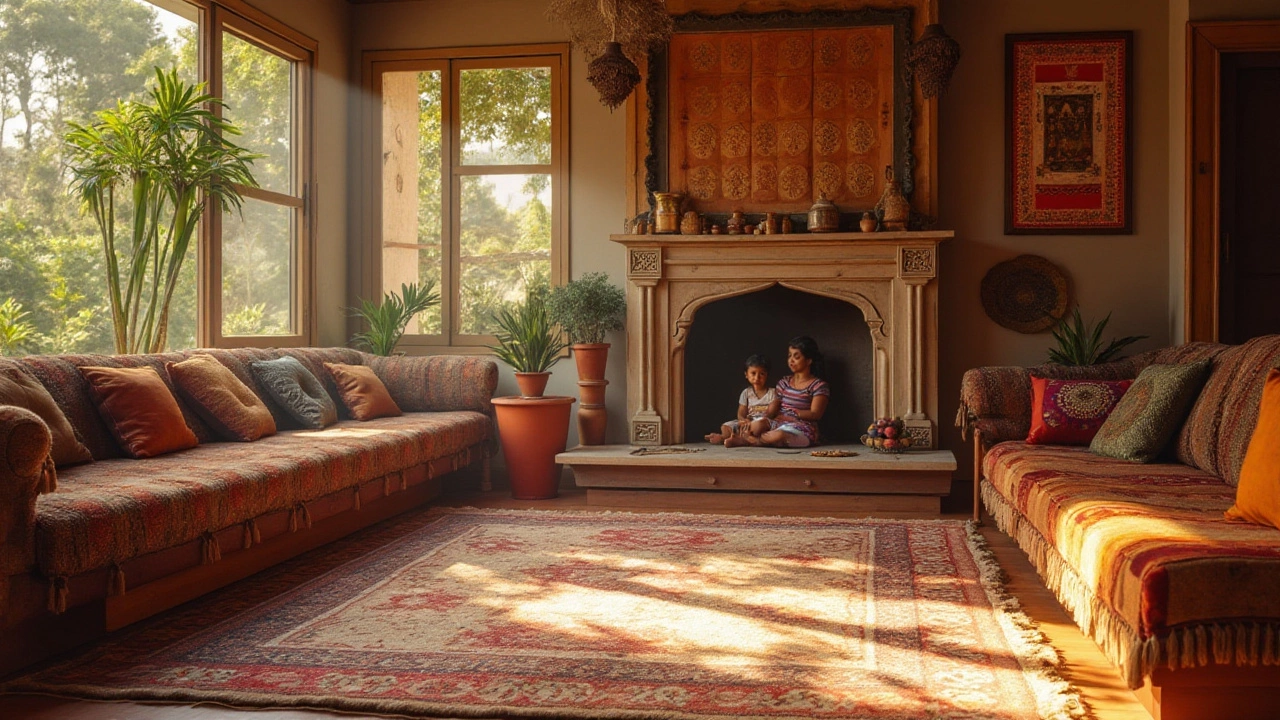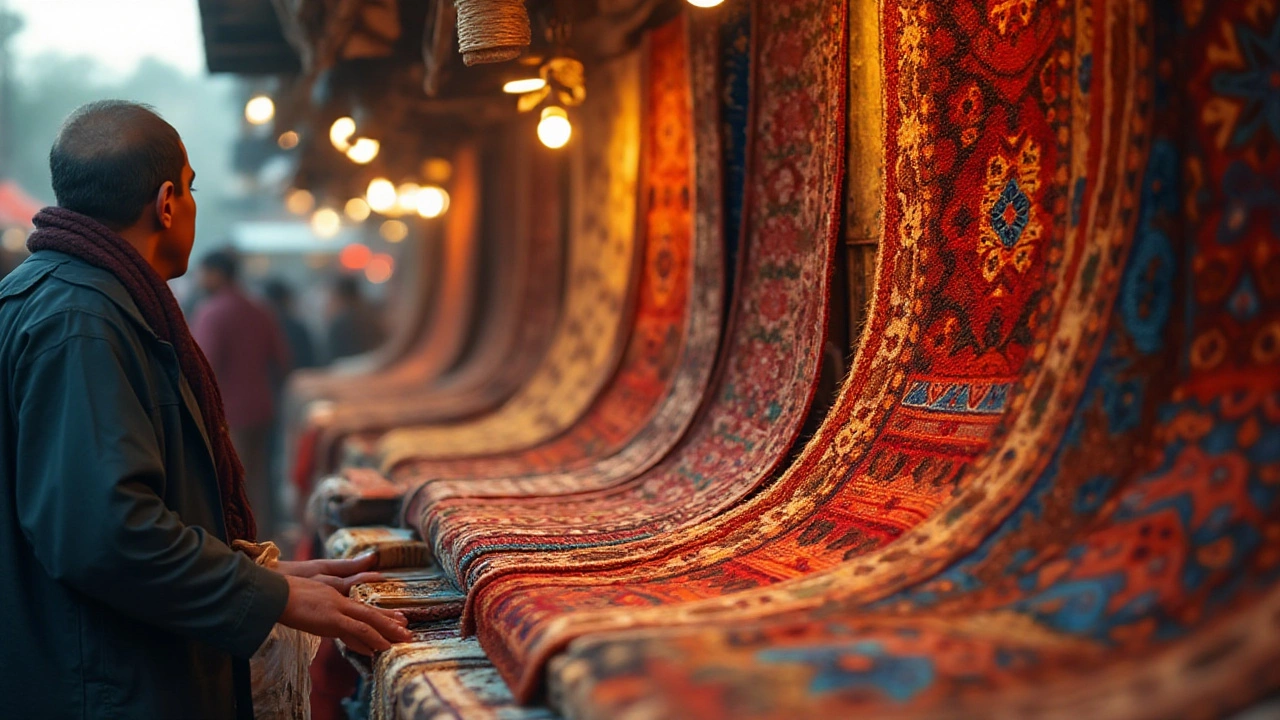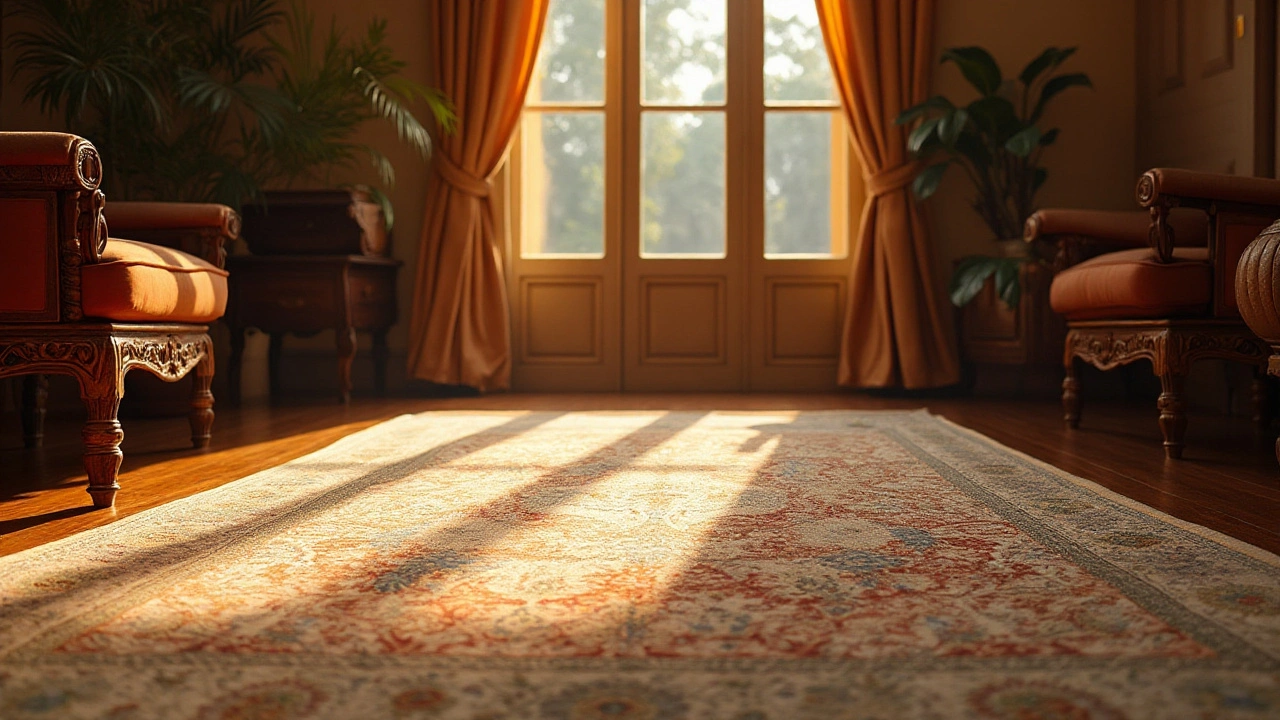Top Rug Materials for Durability and Style

When it comes to selecting the perfect rug for your space, the material plays a critical role. It's not just about picking something that looks good; it's about finding the right balance between aesthetics, function, and longevity. The material determines how your rug will wear over time, how easy it is to clean, and how it feels underfoot. Whether you're cozying up a living room or adding flair to a hallway, selecting the right rug material can make all the difference.
Each material offers a unique set of benefits and challenges. For instance, wool rugs are known for their warmth and durability, making them a popular choice for many homes. If you prefer something lightweight and budget-friendly, cotton might be your go-to. Then there are the eco-conscious choices like jute and sisal, which bring a rustic touch while being kinder to the planet.
Silk rugs bring an element of luxury with their smooth texture and elegant sheen, perfect for spaces where you want to make a statement. Meanwhile, if you're after something more resilient to the rigors of daily life—especially if you've got kids or pets like my trusty companion Rufus—synthetic options might be the way to go. Each option has its own appeal, guaranteeing that there's something out there to perfectly fit your needs and personal style.
- Wool: Warmth and Durability
- Cotton: Casual and Affordable
- Jute and Sisal: Eco-Friendly Options
- Silk: Luxurious and Smooth
- Synthetic Fibers: Practical Alternatives
Wool: Warmth and Durability
Wool rugs have a long-standing reputation for bringing not only comfort but also an element of timeless elegance to any room. As a natural fiber, wool is harvested from sheep and requires no synthetic processing to create the luxurious feel it's famous for. What's remarkable about wool is its ability to remain soft yet resistant, offering a plush experience underfoot without sacrificing strength. This resilience can be attributed to the fiber's natural crimp, which creates tiny air pockets that help wool maintain its shape and provide a cushioning effect. It’s no wonder that generations have trusted wool for crafting fine rugs that can grace both traditional and contemporary settings alike.
One of the standout qualities of wool is its inherent durability. Unlike many materials, wool fibers can bend up to 20,000 times without breaking, which makes them perfect for high-traffic areas. Moreover, wool is naturally flame resistant and doesn't easily catch fire, adding a layer of safety to its myriad of benefits. The fiber's natural lanolin content also adds a protective barrier that makes wool rugs more resistant to stains and dirt, which is a lifesaver for households buzzing with activity. These factors are what make wool a fantastic choice for families and pet owners, enabling such rugs to withstand the antics of both children and pets, including my buddy Rufus.
The warmth that wool brings is another significant factor. As an excellent insulator, wool not only feels cozy underfoot but also helps maintain room temperature. In colder months, wool rugs can make spaces feel warmer, helping to potentially reduce heating costs. Interestingly, wool has a unique ability to absorb humidity, releasing it slowly into the atmosphere, which can contribute to a more balanced indoor microclimate. This moisture-wicking property ensures that while it insulates, your home environment doesn't become a dry, inhospitable place.
"Wool rugs are an investment in both comfort and elegance," says Margaret Kenworthy, a renowned interior designer. "Their aptitude for retaining beauty through years of use while providing unparalleled warmth makes them essential elements in any comprehensive home decor strategy."
In terms of sustainability, wool stands out as an eco-friendly option due to its renewable nature. Sheep naturally produce wool annually, and with proper farming practices, it can remain a sustainable choice. Biodegradable and free from synthetic chemicals, wool rugs decompose naturally, returning nutrients to the soil. For anyone committed to sustainability, wool offers the satisfaction of elegance without the environmental guilt. It's clear that for those looking for rug materials that harmonize comfort, durability, and eco-consciousness, wool comes out as a frontrunner. Investing in wool not only benefits your interior design but also supports the health of our planet, making it a smart and future-conscious choice.
Cotton: Casual and Affordable
When considering materials for your next rug, cotton might not be the first thing that springs to mind, but it should definitely be in the mix. Its casual charm paired with affordability makes it a fantastic choice for those seeking practicality without sacrificing style. Cotton rugs are commonly found in spaces that demand a relaxed atmosphere, like children’s rooms, kitchens, or as an accent piece in a visually busy living area. What makes cotton truly stand out is its ability to hold color well, lending itself to vibrant patterns. This chameleon of fabrics adjusts to different styles effortlessly—think bohemian, coastal, or rustic. When it comes to maintenance, cotton rugs are easy to clean and often machine washable, which is a significant advantage if you're dealing with everyday spills or pet mishaps. This material doesn’t hold dust and allergens like some of its more plush counterparts, making it an ideal choice for sensitive noses.
One of the beautiful things about cotton rugs is their texture—soft to the touch yet firm enough to lay flat and provide excellent coverage. Cotton is a breathable material, allowing it to adapt to seasonal changes, which is something to keep in mind if you experience extreme weather fluctuations. However, cotton as a natural fiber does wear over time, which is why it's important to rotate the rug occasionally. Bear in mind that while cotton is durable, it’s generally best suited for low-traffic areas to avoid excessive wear and tear. In terms of investment, cotton rugs offer a great value proposition. They provide a budget-friendly way to update your home decor without breaking the bank, which leaves room for you to experiment with different themes and colors seasonally or as your tastes change.
"A cotton rug offers versatility and style while giving the homeowner the flexibility to swap out decor as needed," notes an expert from House Beautiful.
A typical aspect where cotton wins is versatility. Cotton rugs come in a wide range of designs, from handwoven options that bring an artisanal touch to your space to printed designs that cater to contemporary tastes. If you're eco-conscious, this fabric offers an additional perk as many cotton rugs are made from recycled materials. This not only supports responsible manufacturing processes but also reduces overall environmental impact. Cotton’s softness and warmth underfoot make it an inviting addition to bedrooms or seating areas where coziness is desired. For creative souls, another benefit is that cotton can often be easily customized or made to order, allowing homeowners to bring personal flair to their interiors. From a sustainability standpoint, opting for quality over quantity ensures that your cotton rug remains a staple in your home for years, enhancing the charming casual ambiance of your space.

Jute and Sisal: Eco-Friendly Options
In the world of rug materials, jute and sisal stand out as the champions of sustainability. These natural fibers have gained popularity, not only for their environmental benefits but also for the unique aesthetic they bring to a space. Both jute and sisal are derived from plants, making them renewable resources. This quality is essential in today's home decor landscape where eco-conscious choices are increasingly valued. Jute, for instance, comes from the stem of the jute plant, thriving in regions like India and Bangladesh. Its fibers are naturally long, soft, and shiny, which are then spun into coarse threads.
Sisal, on the other hand, is harvested from the leaves of the Agave sisalana plant, predominantly grown in Africa and South America. Unlike jute, sisal fibers are stiffer and more robust, contributing to their renowned strength and durability. This makes them ideal for areas with heavy foot traffic. There's something Earthy about introducing these fibers to your decor, marrying rustic charm with functional elegance. Whether you're dressing up a cozy cottage or a modern loft, a rug made from these materials can add that natural touch seamlessly.
Now, here's something you might not know: despite their rugged appearance, jute rugs feel surprisingly soft underfoot. This makes them a pleasant addition to spaces like bedrooms or living areas where comfort is key. Sisal may not claim the same softness; however, it offers a much higher resilience against wear and tear. Both materials boast exceptional insulating properties, perfect for keeping your space warm in winter and cool in summer. According to a quote from renowned interior designer Nate Berkus, "Jute and sisal rugs provide a fantastic textural layer in a room, offering both visual interest and environmental mindfulness."
When it comes to maintenance, both jute and sisal require a specific approach. They are not fond of moisture, and excessive exposure to water can damage the fibers. This means they're best kept away from damp areas like bathrooms or basements. Cleaning involves regular vacuuming with a brush attachment to remove dust and dirt trapped in the natural fibers. For spills, blotting with a dry cloth is advisable. Avoid harsh chemical cleaners since they can weaken and discolor the fibers over time. If you're looking for low-VOC options and want to lessen your carbon footprint, jute and sisal rugs are undeniably strong contenders.
For those wondering about the range of styles, there's no shortage here. From tightly woven designs to chunky braids, the variety is satisfying enough to cater to different tastes. Some homeowners even choose to layer their natural fiber rugs with other rugs to create depth and different textures. Adding color borders or combining them with other materials like wool can elevate the design factor. If you're committed to a greener home, opting for jute and sisal is an investment in both sustainability and style. Imagine strolls across your living room floor, enjoying the subtle character beneath your feet while contributing to an eco-friendly world. It's a conscious step towards making your home decor as mindful as it is beautiful.
Silk: Luxurious and Smooth
Silk rugs evoke a sense of elegance and sophistication that is hard to match. Known for their fine texture and lustrous sheen, silk rugs are often considered the royalty among rugs. Derived from the cocoons of silkworms, silk has been a symbol of luxury and opulence for centuries. The intricate craftsmanship involved in making a silk rug contributes significantly to its allure. Traditional techniques, often passed down through generations, are used to weave these delicate threads into intricate patterns and rich textures.
One of the standout features of silk rugs is their ability to enhance the aesthetics of any space effortlessly. Their reflective quality means they can play with light in fascinating ways, bringing a room to life with subtle color changes throughout the day. While their beauty is undeniable, silk rugs also require careful consideration due to their delicate nature. They are best suited for low-traffic areas where they can be appreciated without the threat of heavy wear, ensuring their beauty is preserved for years to come.
Maintaining a silk rug involves more than meets the eye. These rugs are sensitive to moisture and should be cleaned using specialized methods to prevent damage. Regular vacuuming without the beater bar is recommended to keep debris and dust at bay, while professional cleaning is advised for dealing with spills or stains. The colorfastness of silk means these rugs retain their vibrant hues over time, an attribute that can be seen as a significant payoff for those willing to indulge in their upkeep. According to textile expert Mallory Jacobs, "A silk rug is not just an addition to your home decor; it's a piece of art."
Moreover, silk rugs are incredibly soft underfoot, creating an inviting feel that is a true pleasure to walk on. They are often blended with other materials like wool to enhance durability while maintaining their luxurious appeal. This combination allows for the creation of more robust rugs that can be placed in busier areas without losing that unmistakable silk luster. When choosing a silk rug, it's important to consider the pattern and color that complement the existing decor. Bold designs can serve as a room’s focal point, while neutral tones can add understated elegance to the ensemble.
Quality rugs made from silk often boast impressive detail due to the thinness of the threads, which allows for tighter weaving and more intricate patterns. These rugs typically hail from regions with rich textile heritage, such as Persia, China, and India, known for producing some of the finest silk creations. Investing in a silk rug is a decision that transcends mere practicality. It’s about appreciating the artistry and skill that go into creating these exquisite items. Whether enriching a grand living room or adding a touch of class to a personal nook, a silk rug is a timeless choice for those who value elegance and quality in their home decor.

Synthetic Fibers: Practical Alternatives
For modern homeowners, especially those with active households filled with pets and children, synthetic fibers present themselves as a highly favored choice due to their durability and ease of maintenance. Synthetic rugs are typically crafted from materials like nylon, polyester, and polypropylene. These fibers are renowned for imitating the look and feel of natural materials while providing enhanced longevity and resistance to wear and tear. Their durability makes them particularly suitable for high-traffic areas in your home, where natural fibers might not hold up as well against the daily grind of foot traffic and occasional spills.
Nylon, one of the most popular synthetic fibers, is lauded for its strength and resilience. It can withstand significant foot traffic, making it ideal for entryways and hallways. It's also highly resistant to stains, which is a boon for families with young children or playful pets who might be a little rough on the rugs. On the other hand, polyester is celebrated for its vibrant color retention capabilities. It offers a soft feel underfoot and retains its sheen, making it an excellent choice for spaces where aesthetics are prioritized. Some people find its plush feel a tad too soft but when balanced with its affordability, it’s a trade many are willing to make.
Polypropylene, or olefin, is another synthetic fiber gaining traction for its stain and moisture-resistant properties. Often employed for both indoor and outdoor rugs, olefin boasts a remarkable resistance to fading, making it perfect for sun-drenched areas. A testament to its outdoor resilience, it can make it through seasons without losing its color or integrity. While many might turn up their noses thinking synthetic equals less quality, this couldn't be further from the truth. As Daniel Hardy, a textile expert once mentioned,
"The technologies involved in crafting synthetic rugs today allow these rugs to be just as stylish as their natural counterparts, providing luxury without the heavy maintenance."
These fibers are not just about durability and low maintenance; they are affordable as well. They offer a cost-effective option for homeowners wanting to refresh their interior styling without breaking the bank. This affordability makes it feasible to change styles frequently, adapting to trends or personal preferences with less financial commitment. However, it's essential to note that while they offer amazing advantages, the ecological footprint is a consideration for the environmentally conscious. Unlike natural fibers, synthetic ones are derived from petrochemicals, which aren't biodegradable. But with ongoing advances, manufacturers are exploring more sustainable production methods.
When deciding if synthetic rugs are the right choice, consider your lifestyle, needs, and preferences. An informed decision enhances your decor while serving practical functions. Their blend of aesthetics, resilience, and affordability champions them as practical alternatives in the rug market. Whether you’re working with a grand open-plan area or a cozy nook, synthetic fibers deliver both form and function. The choices available today ensure that you don’t compromise on style, comfort, or practicality.